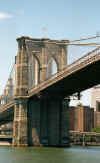| New York
Architecture Images-New York Architects John Augustus Roebling |
|

|
(b. Muhlhausen, Thuringia 1806;
d. New York 1869)
As a father and son, John and Washington Roebling were the foremost American engineers of suspension bridge construction in the nineteenth century. John Roebling was born in Muhlhausen, Thuringia in 1806. While in school he developed an interest in both metaphysics and in bridge building. He graduated with a degree in civil engineering from the Royal Polytechnic Institute of Berlin in 1826. In 1831 Roebling and his brother immigrated to Pennsylvania to farm. When this venture failed, Roebling accepted the position of Pennsylvania state engineer. In this position, he surveyed and supervised the construction of canals, locks, and dams. In 1841 Roebling invented the twisted wire-rope cable, an invention which foreshadowed the use of wire cable supports for the decks of suspension bridges. Six years later he established a factory in New Jersey for the manufacture of this cable. Because the cable could support long spans and extremely heavy loads, Roebling quickly gained a reputation as a quality bridge engineer. John Roebling completed dozens of major works and designed the largest bridge span of his lifetime. A prolific writer, bridge builder and theorist, Roebling's chief published work was Long and Short Span Railway Bridges. Roebling died in New York in 1869 of injuries sustained on the site of a bridge construction. References |